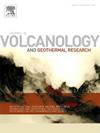Identifying precursors and tracking pulses of magma ascent in multidisciplinary data during the 2018–2023 phreatomagmatic eruption at Semisopochnoi Island, Alaska
IF 2.3
3区 地球科学
Q2 GEOSCIENCES, MULTIDISCIPLINARY
Journal of Volcanology and Geothermal Research
Pub Date : 2025-03-29
DOI:10.1016/j.jvolgeores.2025.108329
引用次数: 0
Abstract
The 2018–2023 phreatomagmatic eruptions at Semisopochnoi Island, Alaska produced abundant long-period (LP) seismicity, harmonic and broadband tremor, and explosion signals over several well-monitored periods of eruption and quiescence. The corresponding dataset provides an excellent opportunity to investigate precursory and syn-eruptive geophysical signals of long-lived phreatomagmatic eruptions using multiparameter observations. We generated explosion and LP event catalogs through novel implementations of the REDPy (Hotovec-Ellis, 2024) repeating event detector in mid-2021 following a network upgrade and the onset of a new phase of the eruption. The hundreds of detected explosions show a high degree of infrasound waveform similarity over more than a year, indicating a repeating source mechanism likely associated with explosive magma-water interaction. The seismic LP catalog shows that events began over a month prior to renewed explosive activity at the beginning of August 2021, and that lower frequency index (FI) LPs were generated in the week prior to the onset of explosions. We applied a recently developed machine learning tool (VOISS-Net, Tan et al., 2024) to catalog abundant broadband and harmonic seismic tremor recorded before and during the renewed explosive activity, along with LPs and explosions. The tremor catalogs complement the LP and explosion catalogs by filling out the seismic sequence with the dominant signal types. Together, these catalogs reveal a seismic sequence of renewed unrest that started with several weeks of LP events, followed by LPs with lower FI values and harmonic tremor in the days prior to explosive activity, and finally the onset of discrete explosions and broadband eruption tremor. We interpret this sequence as the ascent of a new pulse of magma that first interacted with the hydrothermal/groundwater system to produce LPs, followed by harmonic tremor, and that ultimately drove explosive magma-water interactions and periods of continuous ash emissions. The 2021 seismic sequence, in combination with long-term records of satellite SO2 emissions, deformation from interferometric synthetic aperture radar (InSAR) analysis, ash sample analysis, infrasound, and volcano tectonic seismicity, allows us to interpret the entire 9-year period of unrest and eruption that began with an intrusion and earthquake swarm in 2014.
2018-2023年阿拉斯加Semisopochnoi岛火山喷发过程中多学科数据的前兆识别与岩浆上升脉冲追踪
2018-2023年,阿拉斯加Semisopochnoi岛的火山喷发产生了丰富的长周期(LP)地震活动、谐波和宽带震颤,以及在几个监测良好的喷发和静止时期的爆炸信号。相应的数据集提供了利用多参数观测来研究长寿命的呼吸岩浆喷发的前兆和同步地球物理信号的绝佳机会。我们通过REDPy (Hotovec-Ellis, 2024)重复事件探测器的新实现,在2021年年中进行网络升级和爆发新阶段的开始后,生成了爆炸和LP事件目录。在一年多的时间里,数百次探测到的爆炸显示出高度相似的次声波形,表明可能与爆炸性岩浆-水相互作用有关的重复源机制。地震LP目录显示,事件开始于2021年8月初再次发生爆炸活动的一个多月前,并且在爆炸发生前一周产生了较低频率指数(FI) LP。我们应用了最近开发的机器学习工具(voss - net, Tan et ., 2024)来编录在新的爆炸活动之前和期间记录的丰富的宽带和谐波地震,以及lp和爆炸。通过用主要的信号类型填充地震序列,震颤表补充了弱震表和爆炸表。总之,这些目录揭示了地震序列的重新动荡,开始于几个星期的LP事件,随后是低FI值的LP和爆炸活动前几天的谐波震颤,最后是离散爆炸和宽带喷发震颤的开始。我们将这一序列解释为一个新的岩浆脉冲的上升,它首先与热液/地下水系统相互作用产生lp,然后是谐波震颤,最终驱动爆炸性岩浆-水相互作用和连续的火山灰排放期。2021年的地震序列,结合卫星二氧化硫排放的长期记录、干涉合成孔径雷达(InSAR)分析的变形、火山灰样本分析、次声和火山构造地震活动,使我们能够解释整个9年的动荡和喷发时期,该时期始于2014年的一次入侵和地震群。
本文章由计算机程序翻译,如有差异,请以英文原文为准。
求助全文
约1分钟内获得全文
求助全文
来源期刊
CiteScore
5.90
自引率
13.80%
发文量
183
审稿时长
19.7 weeks
期刊介绍:
An international research journal with focus on volcanic and geothermal processes and their impact on the environment and society.
Submission of papers covering the following aspects of volcanology and geothermal research are encouraged:
(1) Geological aspects of volcanic systems: volcano stratigraphy, structure and tectonic influence; eruptive history; evolution of volcanic landforms; eruption style and progress; dispersal patterns of lava and ash; analysis of real-time eruption observations.
(2) Geochemical and petrological aspects of volcanic rocks: magma genesis and evolution; crystallization; volatile compositions, solubility, and degassing; volcanic petrography and textural analysis.
(3) Hydrology, geochemistry and measurement of volcanic and hydrothermal fluids: volcanic gas emissions; fumaroles and springs; crater lakes; hydrothermal mineralization.
(4) Geophysical aspects of volcanic systems: physical properties of volcanic rocks and magmas; heat flow studies; volcano seismology, geodesy and remote sensing.
(5) Computational modeling and experimental simulation of magmatic and hydrothermal processes: eruption dynamics; magma transport and storage; plume dynamics and ash dispersal; lava flow dynamics; hydrothermal fluid flow; thermodynamics of aqueous fluids and melts.
(6) Volcano hazard and risk research: hazard zonation methodology, development of forecasting tools; assessment techniques for vulnerability and impact.

 求助内容:
求助内容: 应助结果提醒方式:
应助结果提醒方式:


